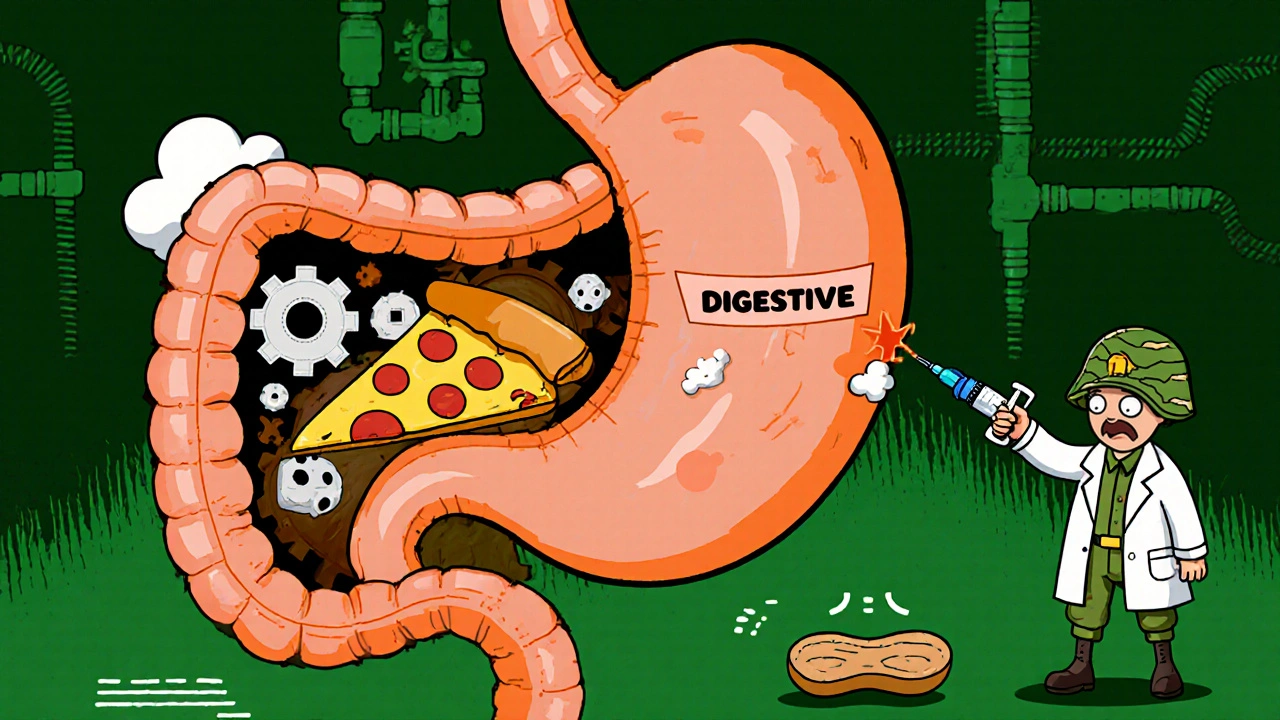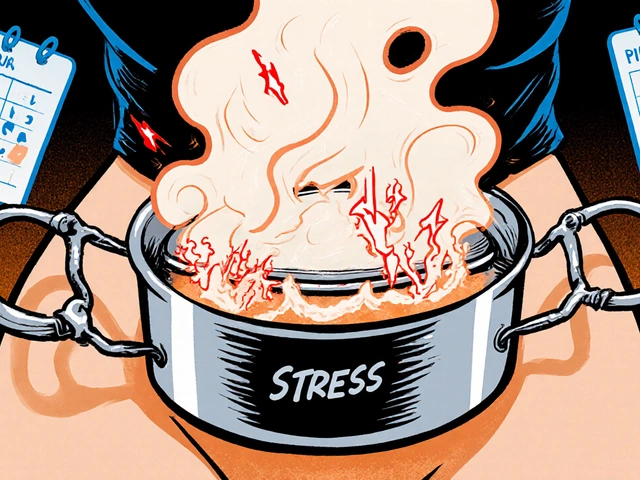When you eat something and get a stomachache, it’s easy to blame it on a food allergy. But not all digestive trouble comes from your immune system going into overdrive. In fact, most stomach issues after eating are caused by something entirely different: food intolerance. The difference between a food allergy and a food intolerance isn’t just academic-it changes how you live, what you eat, and even whether you need to carry an epinephrine injector in your bag.
How Your Body Reacts: Immune System vs. Digestive System
A food allergy is an immune system response. When you eat a food you’re allergic to-like peanuts, milk, or shellfish-your body mistakes the protein for a dangerous invader. It produces IgE antibodies that trigger mast cells to release histamine and other chemicals. That’s what causes hives, swelling, trouble breathing, or worse: anaphylaxis. This reaction can happen within minutes, even from a tiny crumb. Food intolerance is completely different. It doesn’t involve your immune system at all. Instead, it’s a digestive problem. Your body can’t break down certain parts of the food properly. The most common example is lactose intolerance. Most people naturally stop making enough lactase, the enzyme that digests milk sugar, after infancy. Without it, lactose sits in the gut, gets fermented by bacteria, and produces gas, bloating, cramps, and diarrhea. Symptoms usually show up 30 minutes to a few hours after eating.What the GI Symptoms Look Like
Both conditions can cause stomach pain and diarrhea, but the pattern tells the story. With a food allergy, GI symptoms are often part of a bigger reaction. You might vomit violently within 10 minutes of eating shrimp, then break out in hives, feel your throat closing, and get dizzy. These symptoms come fast and hit hard. They’re rarely isolated to the gut. Food intolerance symptoms are slower and more localized. You might eat a slice of pizza, feel fine for an hour, then start bloating, have gurgling in your belly, and pass gas for the next few hours. Diarrhea is common, especially with lactose or fructose intolerance, but you won’t get swelling, itching, or breathing trouble. You can often eat a small amount without problems-like a splash of milk in coffee-while someone with a milk allergy can’t even touch a spoonful.The Big Eight: What Triggers Allergies
In the U.S., 90% of serious food allergies come from just eight foods: peanuts, tree nuts, milk, eggs, wheat, soy, fish, and shellfish. These are the ones the FDA requires to be clearly labeled on packaging under the 2021 FASTER Act. Even trace amounts can trigger a reaction in allergic individuals. That’s why restaurants and food manufacturers have strict protocols to avoid cross-contact. It’s important to note that wheat allergy is not the same as celiac disease or non-celiac gluten sensitivity. Wheat allergy is IgE-mediated-you can react to proteins in wheat like any other allergen. Celiac is an autoimmune disorder triggered by gluten, and non-celiac gluten sensitivity is a poorly understood condition that causes GI symptoms without the immune or autoimmune damage seen in celiac.Testing for Allergies: What Works
If you suspect a food allergy, seeing an allergist is critical. The first step is usually a skin prick test. A tiny drop of the food extract is placed on your skin, then lightly pricked. If you’re allergic, a raised bump (wheal) larger than 3mm forms within 15-20 minutes. Blood tests measure specific IgE levels-anything above 0.35 kU/L is considered positive. But here’s the catch: these tests can give false positives. Up to 50-90% of positive results don’t match real-life reactions. That’s why the gold standard is the oral food challenge. You eat increasing amounts of the suspected food under medical supervision. If you react, you get treated immediately. If you don’t, you’re not allergic. This is especially important for kids with eczema, who often test positive but can eat the food without issue. Newer tests like component-resolved diagnostics look at specific proteins. For peanut allergy, detecting Ara h 2 at levels above 0.23 kU/L predicts a true allergy with 95% accuracy. This helps avoid unnecessary avoidance of peanuts in people who are only sensitive to less dangerous proteins.Testing for Intolerances: No Magic Blood Test
There’s no blood test that reliably detects food intolerances. Don’t waste your money on IgG antibody tests-they’re marketed as “food sensitivity” panels, but the American Academy of Allergy, Asthma & Immunology says they’re not scientifically valid. Sensitivity rates are below 30%, and specificity is under 45%. They lead to unnecessary food restrictions and anxiety. For lactose intolerance, the hydrogen breath test is accurate. You drink a lactose solution, then breathe into a device every 15-30 minutes. If your breath hydrogen rises by 20 ppm above baseline, you’re malabsorbing lactose. The test works because undigested lactose ferments in your colon and produces hydrogen gas. Celiac disease requires two steps: a blood test for tissue transglutaminase IgA antibodies (levels above 10 U/mL suggest celiac), followed by an endoscopy with a biopsy. If the biopsy shows Marsh 3 damage-flattened villi in the small intestine-you have celiac. This is not an intolerance. It’s an autoimmune disease that requires lifelong gluten avoidance. For other intolerances-like fructose, sorbitol, or FODMAPs-the only reliable method is elimination and reintroduction. Remove the suspected food for 2-6 weeks. Then slowly add it back, one at a time, while tracking symptoms. If bloating returns after eating apples, you likely have fructose malabsorption.Why Misdiagnosis Is So Common
A 2023 study found that 80% of people who think they have a food intolerance are wrong. Many are actually dealing with irritable bowel syndrome (IBS), which affects 10-15% of adults. Others have inflammatory bowel disease (IBD), acid reflux, or functional dyspepsia. Symptoms overlap so much that self-diagnosis is risky. Celiac disease is especially underdiagnosed-75% of cases go unnoticed because people assume their bloating is just “sensitive stomach.” But untreated celiac can lead to nutrient deficiencies, osteoporosis, and even intestinal lymphoma. Even doctors can misread allergy tests. A positive skin test doesn’t mean you’ll react when you eat the food. That’s why oral challenges are essential before cutting out major food groups.
Managing Each Condition
If you have a food allergy, strict avoidance is non-negotiable. Always carry two epinephrine auto-injectors (like EpiPen 0.3mg or 0.15mg). They cost $550-$750 without insurance, but they can save your life. Read every label. Ask restaurants about cross-contact. Don’t assume “may contain” is just a disclaimer-it’s a warning. With food intolerance, you don’t need to eliminate everything. Most people with lactose intolerance can handle up to 12 grams of lactose per day-about one cup of milk. Lactase enzyme supplements (like Lactaid) help digest dairy when taken before meals. For sulfite sensitivity, avoid wine, dried fruit, and processed potatoes with added sulfites (above 10 ppm). For non-celiac gluten sensitivity, reducing gluten may help, but it’s not the same as celiac. You don’t need to avoid all gluten-containing grains unless symptoms improve. Some people find relief with low-FODMAP diets, which limit fermentable carbs that feed gut bacteria.When to See a Doctor
See a specialist if:- You’ve had a reaction involving breathing trouble, swelling, or dizziness
- You’ve lost weight without trying or have chronic diarrhea
- Your symptoms keep coming back despite dietary changes
- You’re avoiding multiple food groups based on self-diagnosis
What’s Next in Research
Scientists are working on better ways to tell apart food intolerances. A 2024 study in Nature Communications found specific blood metabolites that distinguish non-celiac gluten sensitivity from IBS with 89% accuracy. That’s a big step toward reliable testing. Organizations like FARE are funding 17 clinical trials as of 2024, exploring new tools like basophil activation tests that measure immune cell responses more precisely. The goal isn’t just to diagnose better-it’s to understand why some people react and others don’t. For now, the best advice remains simple: don’t guess. Get tested. Know the difference between your immune system and your digestive system. And if you’re unsure, talk to a doctor who understands the science-not a wellness influencer selling a 30-day elimination plan.Can you outgrow a food allergy?
Yes, some children outgrow allergies to milk, eggs, wheat, and soy-up to 80% by age 16. Peanut, tree nut, fish, and shellfish allergies are usually lifelong. Regular testing and supervised food challenges can determine if tolerance has developed.
Can food intolerance turn into an allergy?
No. Food intolerance and food allergy are different biological processes. One doesn’t turn into the other. But having one doesn’t protect you from developing the other. Someone with lactose intolerance can still develop a milk allergy, though it’s rare.
Are gluten-free diets healthy for everyone?
No. Unless you have celiac disease, a wheat allergy, or confirmed non-celiac gluten sensitivity, there’s no proven health benefit. Many gluten-free products are lower in fiber, iron, and B vitamins, and higher in sugar and fat. Cutting out whole grains unnecessarily can hurt your gut health.
Why do some people react to food only sometimes?
With food intolerances, the amount matters. A small serving of dairy might not bother you, but a whole glass will. Stress, illness, or gut bacteria changes can also make symptoms worse. With allergies, even a trace amount can trigger a reaction-no matter how you feel that day.
Can stress cause food intolerance symptoms?
Stress doesn’t cause food intolerance, but it can make symptoms worse. Stress affects gut motility and sensitivity, which can amplify bloating, cramping, and diarrhea in people with IBS or lactose intolerance. Managing stress doesn’t fix the intolerance, but it can help reduce how often symptoms flare.






